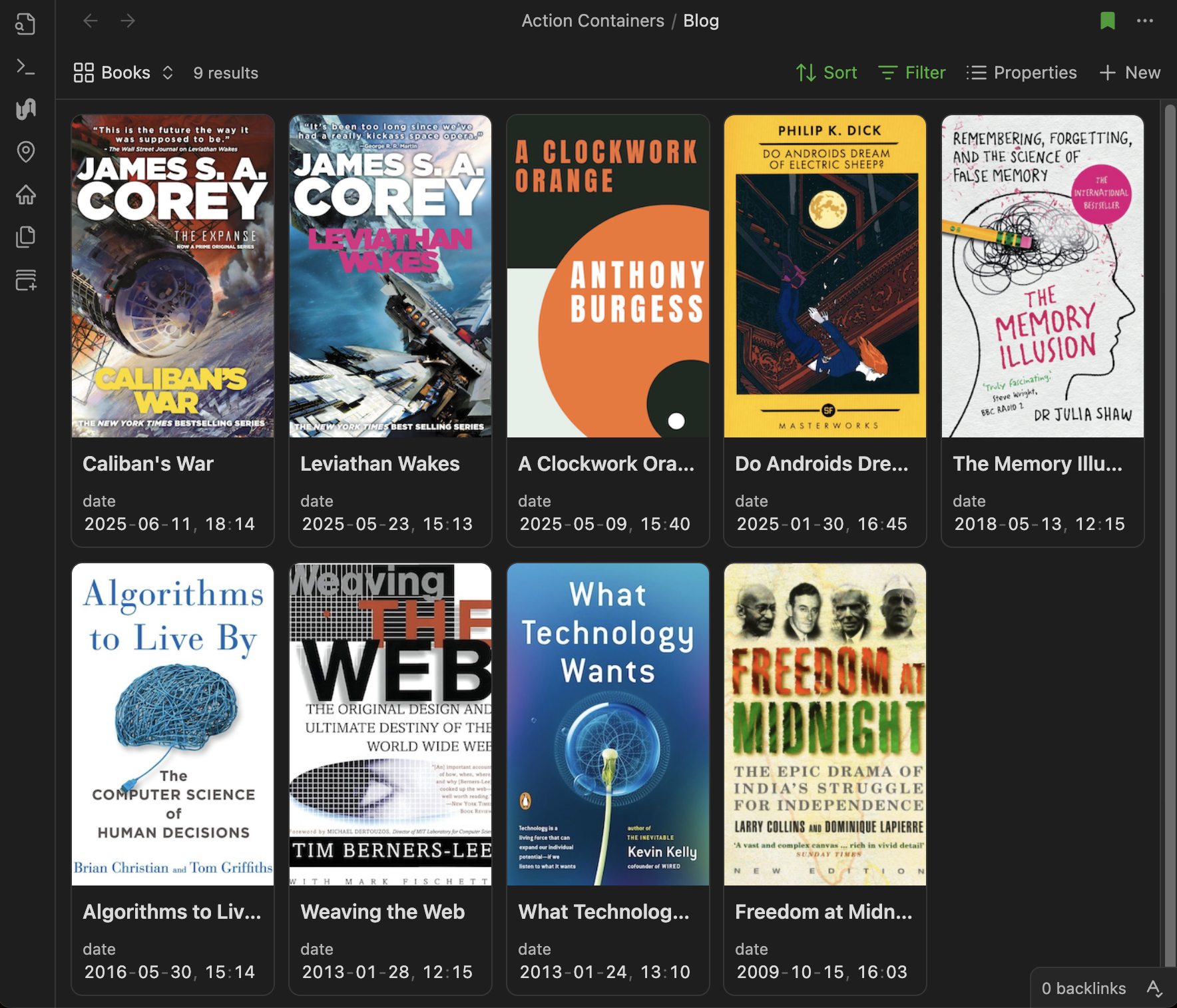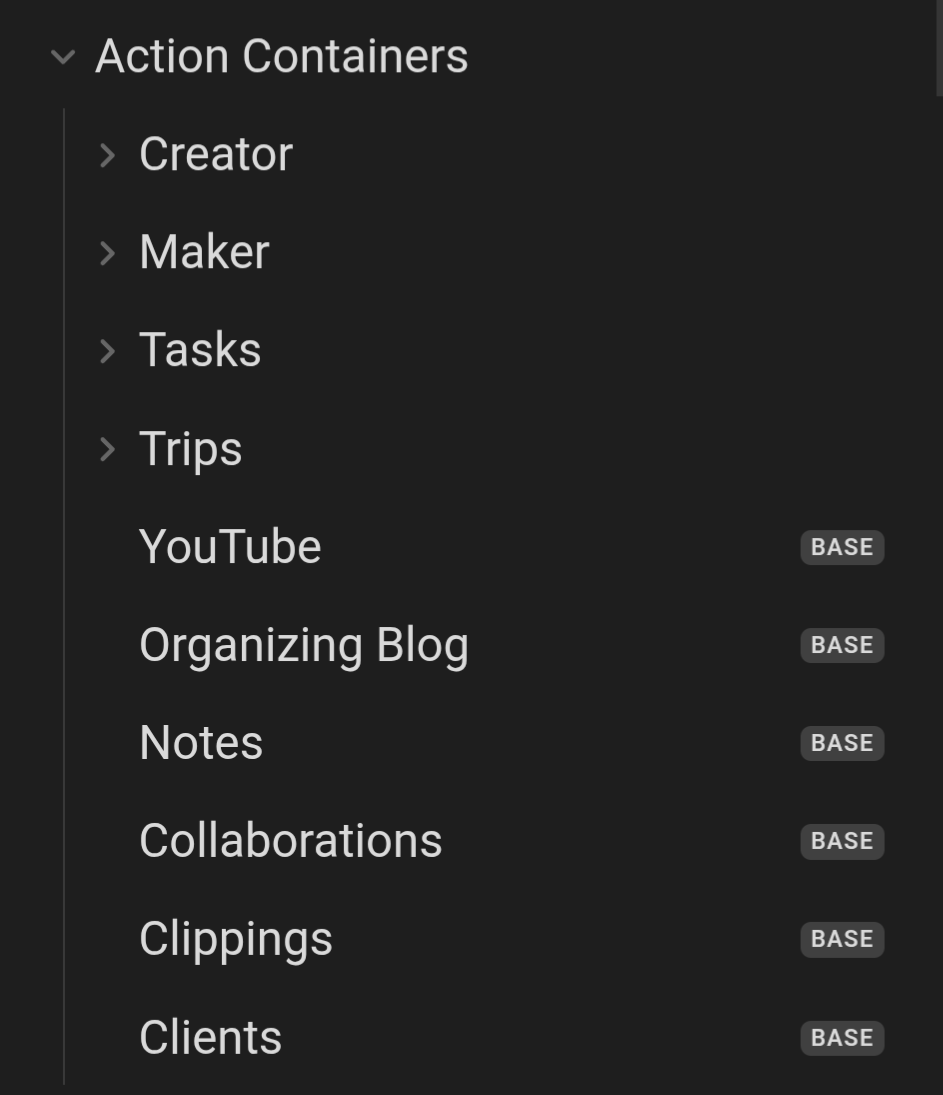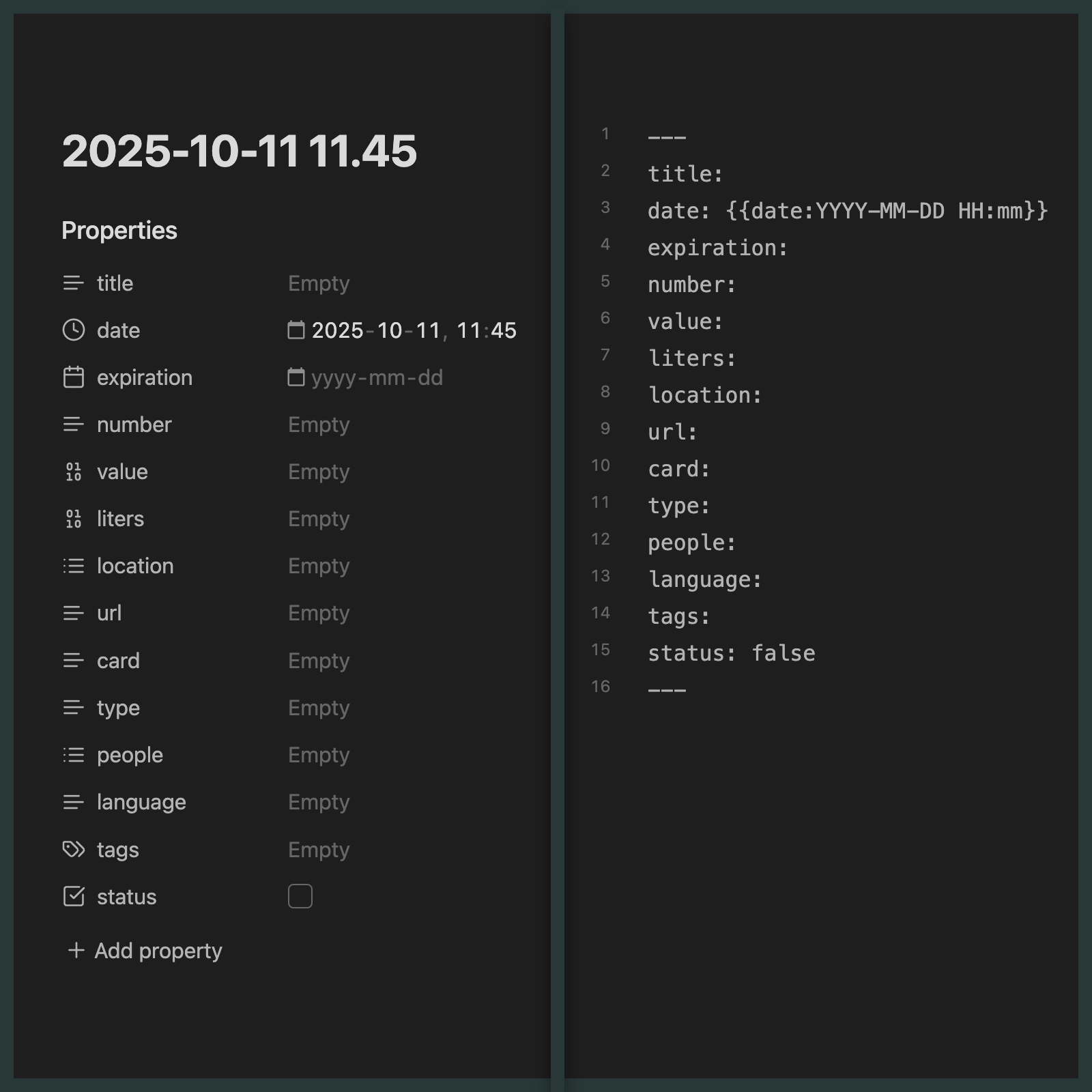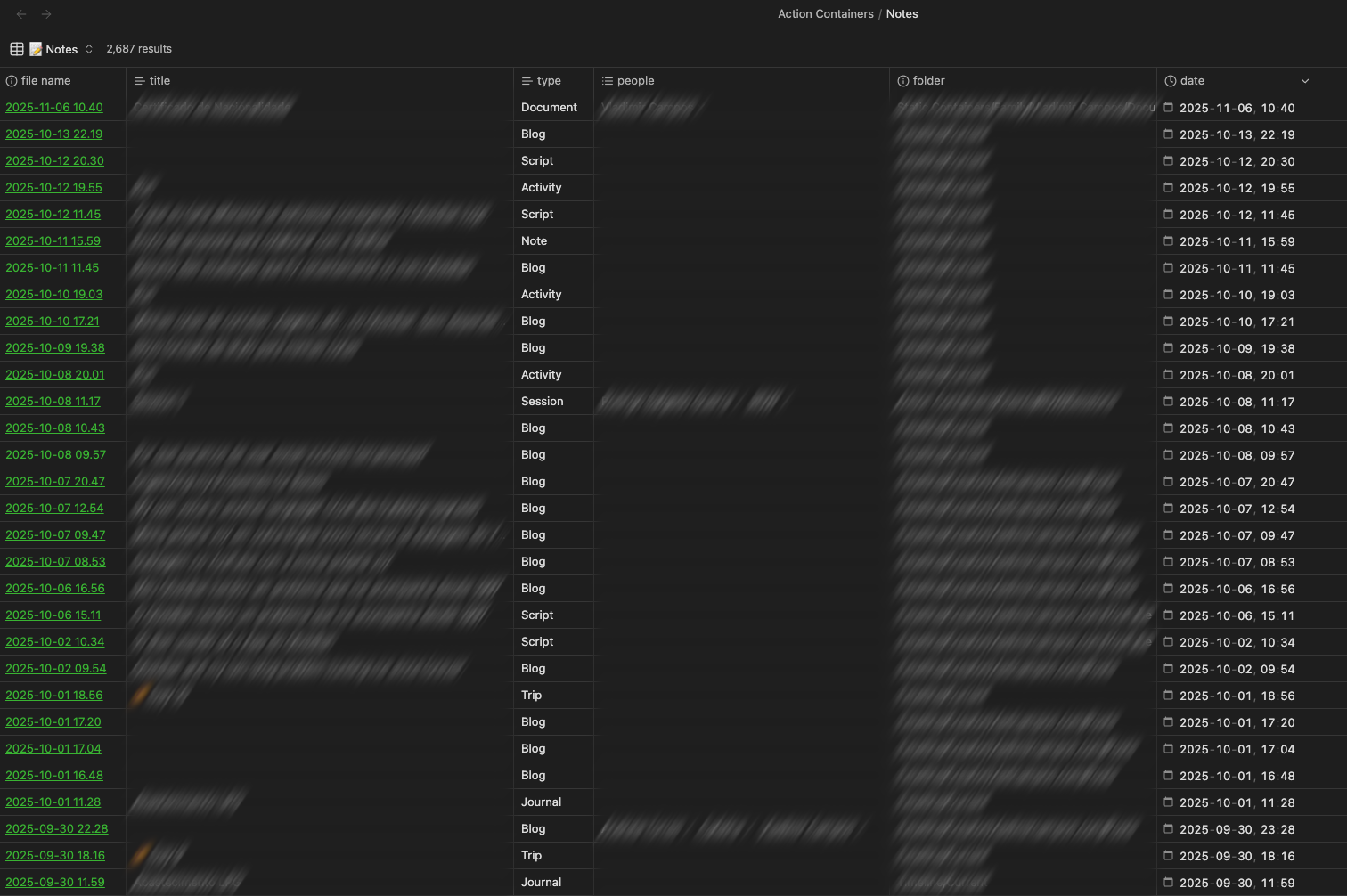Obsidian
- Your Data is Yours
- Your Data is Protected
- Your Data is Portable
Um ano sem Evernote. Valeu a pena migrar?
Migrar do Evernote para o Obsidian não foi uma decisão simples. Além de todo o conteúdo que acumulei por anos, havia uma ligação sentimental com o aplicativo e as conexões pessoais que fiz com outros Experts e a equipe da empresa.
Com relação à aquisição, pessoalmente eu preferia o caminho que eles seguiam antes. Porém, olhando racionalmente para o estado do mercado de aplicativos semelhantes, o tamanho e a estrutura da empresa não faziam mais sentido, quando comparados à concorrência. Em outras palavras, sem a Bending Spoons, o Evernote teria provavelmente desaparecido.
Isso não significa que concordo com o caminho seguido atualmente. Por exemplo, a inclusão de IA em toda parte no aplicativo é algo que não me agrada de forma alguma. Também não gosto de como as notas do Evernote estão cada vez mais isoladas em termos de formato.
Arriscaria dizer que praticamente todos os concorrentes ou usam Markdown, ou permitem importação e exportação neste formato. Não sou desenvolvedor, mas quando olho para as mudanças pós-aquisição, a impressão que tenho é que adorar o Markdown como formato para as notas vem se tornado cada vez mais difícil.
O pioneirismo tem também seu lado negativo. A empresa teve que inventar e decidir muitas coisas pela primeira vez ao longo dos anos. E depois que desbravaram todas essas trilhas, ficou muito mais fácil para os concorrentes que começaram a surgir. Decisões do que incluir em termos de funcionalidade em um novo app não tiveram o peso de potencialmente desagradar parte de uma enorme base de usuários como a do Evernote.
Percebo isso claramente no Obsidian. O aplicativo tem uma série de semelhanças com o Evernote, mas as coisas são feitas de outra forma. Fica muito evidente que olharam para funcionalidades do Evernote com olhos críticos e ajustaram detalhes aqui e ali.
Algo que gosto muito no Obsidian são os plugins, que, pelo que pude perceber em uma recente entrevista que ouvi com o CEO, não estavam originalmente nos planos. Ao menos foi o que entendi. Planejados ou não, eles são uma revolução na forma de adicionar funcionalidades a um app de notas.
Há tantas coisas que tentei por anos fazer no Evernote e que agora faço quase sem esforço usando um plugin. Por exemplo, o sincronismo de anotações e grifos que faço nos meus livros acontece sem complicação alguma. Sem mencionar tudo que foi desaparecendo no Evernote, como o mapa de notas que hoje tenho de volta graças ao Map View.
Um outro exemplo são os textos que escrevo para o blog. Todos eles nascem como notas do Obsidian — inclusive este que você lê agora — e são publicados no blog com a ajuda de um plugin criado pelo Otávio Cordeiro. Quem me acompanha desde a época do iTech Hoje, vai lembrar deste nome.
Considero importantíssimo, ter minhas ideias e artigos já publicados guardados sem esforço no Obsidian. Mais uma vez, é algo que tentei fazer inúmeras vezes com o Evernote e sempre foi complicado ou inviável.
E não há como falar desta migração sem mencionar minha própria mudança. Gradativamente, passei a ver a tecnologia de uma forma muito diferente do que eu via quando comecei a usar o Evernote. Por exemplo, nem cogito o uso de algum novo aplicativo, seja de notas ou qualquer outra coisa, que não me permita ter controle total sobre o conteúdo que guardo nele. Isso se tornou algo tão forte em mim, que venho fazendo um trabalho de migração de antigos aplicativos que usava.
E um subproduto de ter o conteúdo armazenado localmente é a segurança e acesso, mesmo sem conexão. É algo que vários clientes meus vêm percebendo. Ter os dados da empresa e dos clientes deles localmente e integrados a uma ferramenta como o Obsidian, que preza pela privacidade, traz muita tranquilidade para vários gestores. Tenho sido frequentemente procurado para auxiliar na reconstrução de estruturas de dados corporativos usando o armazenamento local como principal.
Enfim, tenho muita saudade dos contatos quase que diários com os amigos que fiz na minha “jornada Evernote”, mas não há a menor hipótese de voltar a usar o aplicativo como ele existe hoje. O Obsidian me atende de uma forma exponencialmente melhor, mas, de forma alguma, significa que seja a ferramenta ideal para você. Pode ser que sim, pode ser que não. No meu caso, não tem volta.
Foi uma decisão difícil, e diria, quase sem querer, mas eu não poderia estar mais contente com este novo lar para minhas memórias, ideias, e muito mais.
Just found out that, of the 364 GB of disk space that I am currently using on my Mac, 101 GB is dedicated to my #Obsidian vault. Or, 109 GB if I count the vaults I use to record my YouTube videos.
I'm not taking my chances anymore. From Apple II to Obsidian—My digital memories now stay local.
I can see how appealing something like the Pixel Journal can be to many people. It’s super convenient and will probably be connected to every single Google service—even Gemini—at some point. But just like the iPhone counterpart, in my opinion, it’s yet another way to imprison users in their platforms.
Pixel Journal now available for the Pixel 8 and 9 series. 9to5Google
I’ve lost just about all my digital notes from before 2008 because of how unreliable backup solutions were and the many times I switched to a different system (Apple II, DOS, Windows, and Mac) and software (WordStar, Word, etc.).
Even many of my posts online, which started as static HTML and then moved to proprietary platforms, were lost several times along the way. Thankfully, I could recover some of them by digging through the Internet Archive, but that’s far from ideal.
In 2008 I started using Evernote, which from the very beginning had something called the 3 Laws Of Data Protection:
The “Portable” part is technically true, and I could move all my notes to Obsidian last year, but it’s not as straightforward as they want you to believe. Anyway, I learned my lesson with the process and decided that my precious memories need better care.
I’m not saying Obsidian is for everyone or that it is the best solution, but having my memories in Markdown format and locally saved first gives me an immense peace of mind. I’m not taking my chances anymore; even my blog posts start as Markdown notes and are locally preserved in that format.
I'm delighted with my library in an Obsidian Bases table
There are some posts on my blog about books I’ve read, and, of course, their notes in Obsidian are categorized with properties, making it pretty easy to create a super-cool Bases table. The one below is one of the views of my Blog.base file, created by filtering notes with the type:Blog and tag:Books properties.

I enjoyed this aesthetic so much that I created a similar view for the Library page on my website. Of course, they are organized in reverse chronological order, and even with only nine books, it’s easy to see how my reading choices changed in 2025.
I remember saying to many friends and family members a few times that I needed a pause from the real world, as it is too crazy to bear. Maybe that’s why I’m reading a lot of fiction this year.
Anyway, because this represents just a tiny fraction of the books I’ve already read, I can’t stop thinking about how cool it would be to have my entire collection displayed like this.
I’ve been gradually replacing my Action Containers subfolders and notes with Obsidian Bases tables. Each one has at least two views: (1) list of notes in progress, and (2) list of all notes of that kind. They are created using the status checkbox property.

Notes is a list of all my .md files (notes) in reverse chronological order.
As for Organizing Blog, that’s a table of posts I have to fix. Long story short, I made a mess when I imported my blog from Obsidian Publish and have been reviewing all my posts since. The status checkbox property is also how I can tell what notes I still need to work on.
Using the Unique Note Creator to save all of my notes and files in a single folder and my Notes table on Bases to find anything, as shown in a recent video, is working so well for me. The only thing I’m missing is a way to take a picture from inside a note on my phone. Imagine if the #Obsidian toolbar had an option like Open Camera to take a picture and have that picture saved in the default folder and the link created in the note.
Em um vídeo recente, expliquei como criar rotas no Obsidian usando o plugin Map View e arquivos geojson ou gpx. Outra possibilidade mais avançada é aperfeiçoar suas rotas juntando algumas delas, cortando partes que não interessam e até mesmo convertendo rotas em um único arquivo.
Acabei de notar que apaguei sem querer a parte da gravação do meu rosto de um tutorial sobre como corrigir rotas feitas no plugin Map View do Obsidian.
Editei o que tinha aqui, ou seja, só demonstrações em tela e o áudio, e achei que ficou um pouco vazio sem meu rosto aparecendo. Mas decidi que vou publicar assim mesmo. Só não será hoje porque câmera e microfone estão no estúdio.
Semana que vem gravo uma pequena introdução explicando o que aconteceu e uma nova parte de encerramento.
A propósito, esse é um vídeo explicando algo muito nerd 🤓
I’ve been doing so many experiments with #Obsidian Bases, but one of the first things I did was to make a list of all my notes to try to mimic the way I used the #Evernote list of notes.
I’m pretty sure some of you will ask me why I blurred tags and other information that doesn’t seem that private. Well, they are. For example, I have my car license plate as a tag, and because it starts with a number, it’s the first one that pops up in the list. Some of the Bases views have the names of places, like where my new home will be. The People property has the names of family members, clients, etc. Anyway, there’s a reason for everything I blurred.
As for having a separate account for the videos, I do have one and use it for most recordings. However, every once in a while I like to share my real account because it has so many details I tailored over the years, and it’s impossible to keep a 100% accurate copy of that in a second account.
Tudo que mudei no meu Obsidian recentemente
As mudanças que venho fazendo no meu Obsidian só confirmam o que mencionei em uma live recente. Sem um bom conjunto de propriedades, fica muito difícil encontrar informações, porque qualquer tipo de filtro no Obsidian — da busca tradicional ou avançada até o Bases ou o Dataview — depende de categorias adicionadas às notas por nós.
Propriedades
As propriedades que uso ocupam quase toda parte visível da nota, mas elas sempre aparecem fechadas quando abro ou crio uma nova nota. Se preciso ver ou modificar algo, uso o atalho de teclado option + command + m , como demonstrado neste vídeo.
Meu objetivo desde o início foi encontrar um equilíbrio entre simplificar o processo de anotar e guardar informações e, ao mesmo tempo, poder usar filtros baseados nas propriedades para criar os mais variados grupos de notas e arquivos. As 14 propriedades que atualmente me ajudam neste processo ficam em um único modelo de nota (Template), como pode ser visto na imagem abaixo.

Minha mais nova propriedade, status: false, cria uma caixa de checkbox desmarcada em todas as notas daqui por diante. A caixa desmarcada significa algo ainda em uso — Action ou Static —, enquanto a marcada indica uma nota da Timeline. Por exemplo, no caso de ideias e artigos que publico no meu site, o plano é criar as notas para possíveis postagens e usar uma tabela do Bases para filtrar as que contêm a propriedade type:Blog e com a caixa status desmarcada. Ao publicar o post, basta marcar a caixa e a nota desaparecerá da tabela de ideias.
Poderia expandir isso para outros tipos de nota, inclusive as que estão no meu Static Container. Por exemplo, as notas dos meus documentos pessoais com a caixa status desmarcada seriam os documentos ainda válidos e poderiam aparecer numa tabela de consulta. Em teoria, é perfeito, mas dada a quantidade de notas que tenho no meu cofre, é inviável sincronizar todo meu conteúdo com o telefone. Por conta dessa limitação técnica, precisei pensar numa alternativa diferente para o que mantenho na estrutura Static. Mais abaixo no texto, explico isso em mais detalhes.
O genial é que, por conta de como o Bases funciona, todas as minhas notas podem ser criadas nas pastas da Timeline. Em outras palavras, no destino final delas. Ou seja, as tabelas do Bases, continuam respeitando as regras do Timeline System. Por exemplo, uma tabela de documentos válidos ficará na pasta Static. Tabelas listando possíveis postagens para meu blog, roteiros de vídeos para o YouTube e as colaborações e clientes em andamento ficam na pasta Action. Enfim, como no Bases não importa onde as notas estão, posso criar todas elas na Timeline.
Pasta Única
O problema é que manter todos os meus arquivos em uma única pasta na Timeline é um desafio em dobro.
Primeiro, porque tenho receio de que posso não encontrar algum arquivo nas estruturas tabelas do Bases que estou construindo. Afinal, boa parte desse processo ainda está em teste. Portanto, para evitar problemas, farei minhas experiências usando somente as notas que criarei daqui por diante. Se após algumas semanas eu sentir confiança no que fiz, migrarei o restante das notas.
O segundo desafio é técnico. As pastas no meu Obsidian também existem para me ajudar a filtrar o que quero sincronizar com meu telefone. Faço isso com algumas regras no Syncthing que definem quais pastas devem ser sincronizadas em cada dispositivo.
Tecnicamente falando, infelizmente não posso ter tudo dentro de uma única pasta. Por ora, o que me ocorreu foi criar a pasta Timeline/Currentque conterá minhas notas de diário, posts, scripts, e outros tipos de notas que crio diariamente.
Essa pasta fará parte das que são sincronizadas e, à medida que o espaço no telefone for ficando menor, vou ao Obsidian no meu computador e movo algumas notas mais antigas para a pasta na Timeline onde estão as demais notas. Ou seja, no próximo sincronismo, elas desaparecerão do telefone.
Obviamente, o cofre inteiro permanecerá nos dois computadores que estão sendo sincronizados e também fará parte dos dois backups que tenho, um em casa e outro no escritório.
Título de Arquivos e Notas
Desde que comecei a testar essas mudanças, as minhas novas notas passaram a ter o título do arquivo no formato YYYY-MM-DD HH.mm. Já o título que quero para a nota, passou a ser incluído na propriedade title. Isso garante que terei sempre títulos únicos nos nomes de arquivo e, ao mesmo tempo, poderei usar qualquer tipo de caractere no título que quero dar para a nota.
Com a ajuda de uma tabela que faz o papel de uma lista de todas as minhas notas, posso ver ambos, o título do arquivo (ou seja, a data/hora) e o título da nota, um ao lado do outro, como demonstro no vídeo abaixo.
Unique Note Creator
Usando sempre o Unique Note Creator, todas as minhas notas são criadas na pasta Timeline/Current com a data e hora e as 14 propriedades. Ou seja, tudo que tenho que lembrar de fazer é preencher os dados nas propriedades que fazem sentido para aquela situação.
E falando em tabelas, a minha maior tabela é a Notes, sendo basicamente uma lista de todas as minhas notas em ordem cronológica (vídeo acima), usando o título do arquivo como sistema de ordenação.
O objetivo da tabela é funcionar como uma lista gigante que me ajudará a encontrar as minhas notas de forma muito similar ao que eu fazia no Evernote. Por ora, tenho também colunas com as propriedades title, type, people, tags (que não está visível na imagem abaixo) e a pasta onde a nota está.

Já a coluna date provavelmente vai ser removida no futuro. Ainda a mantenho ali porque esta propriedade existe desde que comecei a usar o Obsidian e foi também escolhida para as datas das notas que importei do Evernote. Enfim, as novas notas sempre tiveram a data automaticamente adicionada, o que significa que é a forma mais segura de saber qual é a data de criação de tudo que tenho no cofre.
Trabalho em Progresso
O interessante da visualização Notes que criei no Bases é que, como ali estarão todas as minhas notas, tudo que eu fizer lá, vai automaticamente ajustar informações nas outras visualizações e vice-versa. Ou seja, à medida que eu for organizando notas em uma das tabelas, estarei organizando qualquer visualização atual ou que eu crie no futuro.
O plugin Map View já era um dos meus preferidos, mas ele ficou ainda melhor com as incríveis novidades da versão 6.
Minhas rotas de corridas, viagens, etc., no Obsidian. Sem depender do Google Maps!
Meu mapa do Obsidian está agora muito mais interessante. Com a versão 6 do plugin Map View, consigo ver as rotas das minhas corridas, viagens, trilhas etc. E, graças ao OpenStreetMap, não preciso continuar expondo minhas informações pessoais no Google Maps.
Links
Novo formato de título para minhas notas
Continuo pensando sobre as mudanças que mencionei neste outro post. A ideia que tive hoje foi que todas as notas criadas de agora em diante terão como nome do arquivo apenas a data e hora criados automaticamente, com o formato que já mencionei antes:
YYYY-MM-DD HH.mm
Mas quando fizer sentido, elas terão também um título de verdade, que ficará na propriedade Title.
Como no meu arquivo Timeline.bases, a primeira coluna é a data da propriedade Date e a segunda coluna a propriedade Title, a lista ficará sempre ordenada por data de criação com os títulos ao lado das datas.
Outra coisa que penso em fazer, é renomear o arquivo Timeline.bases, mas isso explicarei em um outro post, quando a ideia já estiver mais amadurecida 😉
Ando refletindo muito sobre a simplificação das pastas que tenho no meu #Obsidian. Apenas ‘pensando alto’… e se eu criar novas notas dentro de uma única pasta e usar visualizações do Bases para filtrar informações com base em propriedades? Tenho feito alguns testes e está funcionando muito bem.
O arquivo chamado Timeline.bases tem atualmente 5 visualizações. A principal é “Notes”, que mostra todas as minhas notas em ordem cronológica com base na data e hora que estão na propriedade “Date”. Depois tenho “Journal”, “Trips”, “GPL” e “Clientes”. Cada qual filtrando notas com base em propriedades específicas. Mas todas as visualizações têm em comum o uso da propriedade “Date” como filtro primário.
Com a ajuda do plugin oficial Unique Note Creator já estabeleci que todas as notas devem ser criadas na mesma pasta e basta configurar cada nova nota com as propriedades corretas.
Nada mudaria na forma de usar os três Containes de Informação do Timeline System—Action, Static e Timeline—, mas as informações dentro de cada um viriam de tabelas do Bases. Essa última parte é, definitivamente um pouco mais complicada e ainda não pensei em detalhes sobre o assunto, mas acredito que seja possível fazer.
I’m finally down to a single template with every property I need, which greatly simplifies the process of creating #Obsidian Bases tables. 🫣 What about enough screen space for taking notes?
Meu Obsidian herdou um problema que me acompanha desde 1997
Manter todo o meu conteúdo no Obsidian significa ter uma rede de conexões tão profunda, que é praticamente impossível levar parte das minhas notas para outro cofre sem quebrar dezenas de links. Enfim, tive que repensar a minha estratégia de ter um cofre para cada blog.
O que terminei por fazer foi algo que tem um ar de proibido e que tem potencial para criar inúmeros problemas. Criei um cofre dentro de outro cofre.
Links
Obsidian and my two-blog problem hunting me since forever.
As you may remember, I have two websites: one in Portuguese and another in English. This is something I have to constantly take into account when looking for hosting, social media, and, honestly, almost any other online activity.
When I was using Obsidian Publish, I ended up creating /en and /pt sections in the same site, but that came with several problems back then and now. For example, Micro.blog offers up to a five-blog plan, but all the posts go to the same ActivityPub feed. That’s not ideal when the blogs have different topics or languages. So, when I decided to move back to Micro.blog, I opted for two different blogs, which immediately created another problem.
I use the Micro.publish plugin to post from Obsidian, and of course, it has to be logged in to my Micro.blog account, which is now two accounts.
The first idea I came up with to fix this was to create two new vaults, one for each blog. Technically speaking, that worked very well. But it didn’t take long to see how incompatible it was with the way I use Obsidian. My notes and files are all interconnected using tags, properties, and even links. For example, I might create a trip journal note and link that to a blog post, or use an image from a note in a post. The web of connection is so deep that when I moved both blogs to different vaults, it broke many links. So, I’m back to having both blogs in my main vault.
After giving it some thought, I came up with a workaround that, to be honest, is not 100% safe. Each site has its own directory in my vault, and my main Obsidian is connected to the Portuguese Micro.blog account. Then, I created a nested vault using the English site subfolder and connected that second vault to my other Micro.blog account.
Yes, that’s a recipe for disaster if one is not careful.
To make it less prone to making a big mess, I took some precautions. The second vault now has a red accent color to make it clear I’m in a dangerous zone. In addition to that, I changed the Default location for new attachments to Same folder as current file and the New link format to Shortest path possible.
To be entirely transparent, saving attachments in the same folder is something I started experimenting with a few days ago, when I went on a trip and only used Obsidian on my phone for 10 days. That was an experience in itself, as I noticed how tricky it can be to use the app on a phone 100% of the time, but that’s a story for another day.
Back to the multiple-blog problem. Yesterday, I posted a test from the second vault, and it worked flawlessly. This will be the second post from there, but this one has links, tags, and other potential failure points.
Anyway, this multiple-language situation has been haunting me since I started my first website back in 1997, and I believe it will stick with me forever.
Essa foi a manhã do dia dois de uma viagem inesquecível que fiz com minha maravilhosa esposa e meu adorável chãozinho. Acampamos na Espanha e França, e ao longo do caminho paramos em vários locais inusitados para apreciar a vista e algumas vezes até fiz café.
Além de ter sido uma aventura incrível que infelizmente está chegando ao fim, notei que usar o Obsidian 100% do tempo no telefone é bem diferente da experiência que tenho no computador, apesar de praticamente todas as funções estarem presentes em ambos.
Enfim, fiz alguns ajustes na forma de usar o app e em breve publicarei alguns vídeos compartilhando minhas ideias e experiências.
Hoje tive a certeza de que estou 100% adaptado ao #Obsidian. Muitos de vocês têm me recomendado o plugin Notebook Navigator, que cria uma interface de navegação parecida com a do #Evernote. Instalei há pouco para fazer alguns testes e imediatamente me senti completamente fora do meu habitat natural.
O plugin parece muito interessante e pretendo experimentar as funcionalidades em um dos mus cofres para testes. Quem sabe até produzo um vídeo. Mas não durou nem mesmo alguns segundos no meu cofre principal 🫣. Desinstalei pouco dempo depois de começar a navegar um pelas pastas.
Como o Obsidian viabilizou o projeto Home das Cavernas Digital.
O termo ‘Homem das Cavernas Digital’ é uma invenção recente, mas a ideia de ter todo meu conteúdo concentrado em um local que esteja sob meu controle é muito antiga, vem da época em que comecei a usar o Evernote. Aliás, antes disso eu já vinha tentando criar uma estrutura de pastas que eu pudesse usar no meu Palm e no meu computador ao mesmo tempo.
Lembro que quando os novos modelos de Palm começaram a vir com leitores de cartão de memória, passei a andar com um leitor de cartões USB no meu chaveiro. Com todos os arquivos em um mesmo local, era possível conectar o cartão ao meu computador do trabalho para ler os documentos .doc e .xls, que no Palm eu conseguia abrir usando o app Documents To Go

De volta o presente, a contribuição do Obsidian, foi simplificar o projeto. Como o app é basicamente um conjunto de pastas do meu computador, se eu colocar tudo naquelas pastas, será muito mais fácil sincronizar, fazer backups, etc.
Finalmente, uma das coisas que o Obsidian me permite fazer é interligar todo esse conteúdo que produzo. Das minhas anotações pessoais a tudo que publico online.